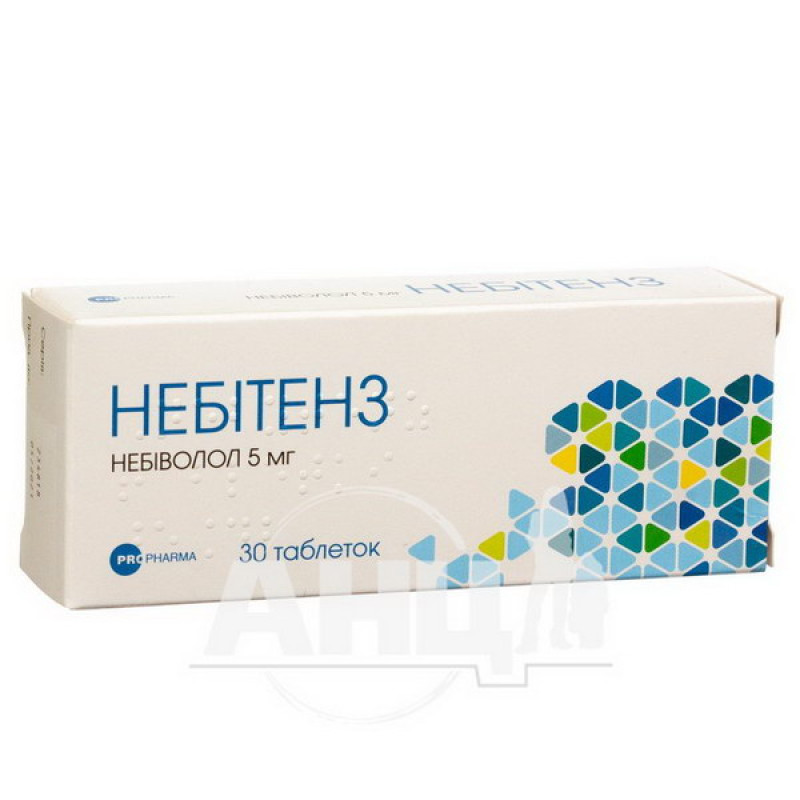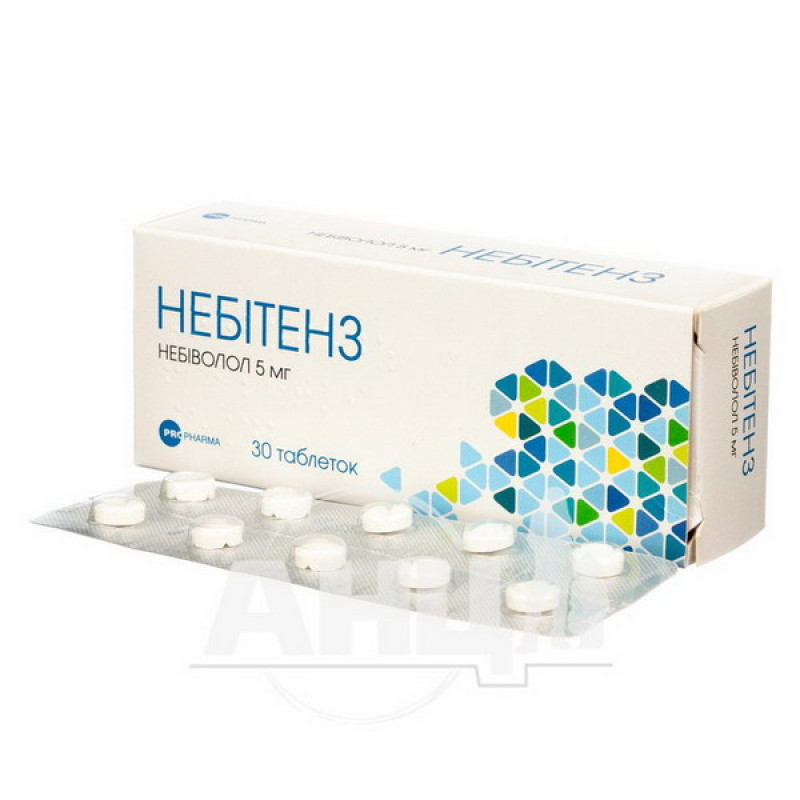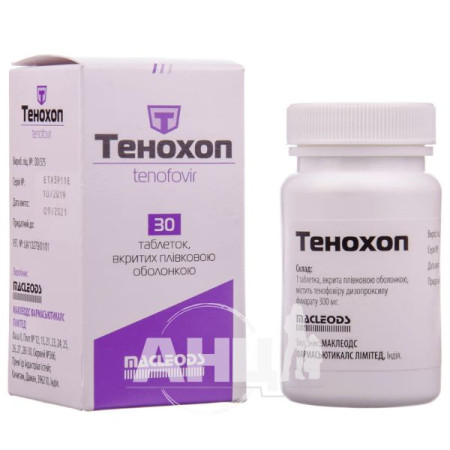Nebitenz tablets 5 mg blister No. 30

Pharmacological properties
Pharmacodynamics. Nebivolol is a racemate consisting of two enantiomers: srrr-nebivolol (d-nebivolol) and rsss-nebivolol (l-nebivolol). It combines two pharmacological properties: due to the d-enantiomer, nebivolol is a competitive and selective blocker of β1-adrenoreceptors, due to the l-enantiomer it exhibits mild vasodilating properties due to metabolic interaction with l-arginine / nitric oxide.
With single and repeated use of nebivolol, the heart rate at rest and during exercise decreases in both normal blood pressure and hypertensive subjects. The antihypertensive effect is maintained during long-term treatment. In therapeutic doses, α-adrenergic antagonism is not observed. With short-term and long-term treatment with nebivolol in patients with hypertensive subjects, systemic vascular resistance decreases. Despite the decrease in heart rate, the decrease in cardiac output at rest and during exercise is limited due to an increase in stroke volume. The clinical significance of the hemodynamic difference compared to other β-adrenergic blockers has not yet been sufficiently studied. In patients with hypertensive subjects, nebivolol increases the vascular response to acetylcholine mediated by nitric oxide; in patients with endothelial dysfunction, this response is reduced. The use of nebivolol as an adjunct to standard therapy for chronic heart failure with or without reduced left ventricular ejection fraction significantly prolongs life expectancy in patients with cardiovascular disease. The effect of nebivolol does not depend on age, gender, or left ventricular ejection fraction. In patients receiving nebivolol, a decrease in the incidence of sudden death was found.
Pharmacokinetics. After oral administration, both enantiomers of nebivolol are rapidly absorbed. The absorption of nebivolol is not affected by food, so it can be taken regardless of food. Nebivolol is metabolized in the liver, in particular, with the formation of active hydroxymetabolites. The bioavailability of orally administered nebivolol is on average 12% in fast metabolizers and is almost complete in slow metabolizers. Based on the difference in metabolic rate, the dose of nebivolol should be adjusted depending on the individual needs of the patient, and slow metabolizers should be prescribed low doses. In fast metabolizers, the T ½ value of the enantiomers of nebivolol from blood plasma is on average 10 hours, and in slow metabolizers - 3-5 times longer. The concentration of nebivolol in blood plasma is proportional to the dose in the range of 1-30 mg. Age does not affect the pharmacokinetics of nebivolol. One week after administration, 38% of the dose is excreted in the urine and 48% in the feces. Urinary excretion of unchanged nebivolol is less than 0.5% of the dose.
Indication
Essential ag. chronic heart failure as an adjunct to standard therapy in elderly patients ≥70 years of age.
Application
Essential ag. for adult patients the dose is 5 mg (1 tablet) of nebivolol 1 time per day. the drug can be taken with meals, preferably at the same time. the hypotensive effect is manifested after 1-2 weeks of treatment. however, the optimal hypotensive effect is achieved after 4 weeks of administration. nebitenz can be used both for monotherapy and in combination with other antihypertensive agents. so far, an additional hypotensive effect has been observed only when it is combined with 12.5-25 mg of hydrochlorothiazide.
Chronic heart failure. Treatment of chronic heart failure should begin with slow dose titration until reaching the individual optimal maintenance dose. Such patients are prescribed the drug in the presence of chronic heart failure without episodes of its acute decompensation within the last 6 weeks. The doctor should have experience in the treatment of heart failure. Patients who use other cardiovascular drugs (diuretics, digoxin, ACE inhibitors, angiotensin II receptor antagonists) with an already established dose within the last 2 weeks before starting treatment with nebivolol.
As a rule, treatment of chronic heart failure with nebivolol is long-term. Treatment with nebivolol should not be stopped abruptly, as this may lead to an increase in heart failure symptoms. If discontinuation of the drug is necessary, the dose should be reduced gradually, by half per week.
Patients with renal insufficiency. Since the dose is titrated to the maximum tolerated dose individually, no dose adjustment is required in mild to moderate renal insufficiency. Experience in patients with severe renal insufficiency (plasma creatinine ≥250 μmol/l) is limited, therefore nebivolol is not recommended for such patients.
Patients with hepatic insufficiency. Nebivolol is contraindicated due to insufficient experience with the drug.
Contraindication
Hypersensitivity to any of the components of the drug. hepatic failure or severe liver disease. acute heart failure, cardiogenic shock or episodes of decompensated heart failure requiring the administration of active substances with a positive effect. sick sinus syndrome, including sinoauricular blockade, AV blockade II-III degree (without an artificial pacemaker). bronchospasm and BA in history. untreated pheochromocytoma. metabolic acidosis. bradycardia (before the start of treatment, heart rate 60 beats / min). arterial hypotension (systolic blood pressure 90 mm Hg. Art.), severe peripheral circulatory disorders.
Side effects
Side effects in essential hypertension and chronic heart failure are listed separately due to differences in the underlying diseases of these conditions.
essential AG
organ system
often
(≥1/100, /10)
Not often
(≥1/1000, /100)
Very rare (≥1/10,000)
frequency unknown
Mental disorders
Nightmares, depression
CNS disorders
Headache, dizziness, paresthesia
syncope
Visual impairment
visual impairment
Cardiac disorders
Bradycardia, heart failure, AV conduction delay/AV block
Vascular disorders
Arterial hypotension, increased intermittent claudication
Respiratory tract disorders
dyspnea
bronchospasm
Gastrointestinal disorders
Constipation, nausea, diarrhea
Dyspepsia, flatulence, vomiting
Skin disorders
Pruritus, erythematous rash
Worsening of skin manifestations of psoriasis
Reproductive system disorders
impotence
General violations
Increased fatigue, edema
Immune system disorders
Angioedema, hypersensitivity
Adverse reactions caused by some β-adrenergic blockers have also been reported: hallucinations, psychosis, confusion, cyanosis of the extremities, Raynaud's syndrome, dry eye, and practolol-type oculomucocutaneous toxicity.
Chronic heart failure.
The most common adverse reactions reported in patients taking nebivolol were bradycardia and dizziness. The following adverse reactions, potentially related to the drug, have been reported and are considered characteristic and relevant in the treatment of chronic heart failure: worsening of heart failure symptoms; orthostatic hypotension; first-degree AV block; swelling of the lower extremities.
Special instructions
Maintenance of β-adrenergic blockade reduces the risk of cardiac arrhythmias during intubation and induction of anesthesia. β-adrenergic blockers should be discontinued at least 24 hours prior to surgery. Caution is required when using certain anesthetics that cause myocardial depression, such as cyclopropane, ether, or trichloroethylene. Vagal reactions in the patient can be prevented by intravenous atropine.
Patients with untreated chronic heart failure should not be given β-blockers until the condition is stabilized. β-blocker therapy in patients with coronary artery disease should be discontinued gradually - over 1-2 weeks. If necessary, to prevent exacerbation of the disease, it is recommended to simultaneously start treatment with a replacement drug.
Beta-blockers can cause bradycardia. If the resting heart rate drops to 50-55 beats/min and/or the patient develops symptoms suggestive of bradycardia, the dose should be reduced.
β-Adrenergic blockers should be used with caution in the treatment of: a) patients with peripheral circulatory disorders (Raynaud's syndrome, intermittent claudication), as exacerbation of these diseases may develop; b) patients with first-degree AV block due to the negative effect of β-adrenergic blockers on conduction; c) patients with Prinzmetal's angina due to unobstructed α-adrenergic mediated vasoconstriction of the coronary arteries (β-blockers may increase the frequency and duration of angina attacks).
Beta-blockers may mask the symptoms of tachycardia in hyperthyroidism. These symptoms may worsen if therapy is abruptly discontinued.
In patients with COPD, β-adrenergic blockers should be used with caution as airway constriction may be increased.
Patients with a history of psoriasis should be prescribed β-adrenergic blockers only after a thorough assessment of the situation.
Beta-blockers may increase sensitivity to allergens and the severity of anaphylactic reactions.
The drug contains lactose, so it should not be prescribed to patients with hereditary galactose intolerance, lactase deficiency or glucose-galactose malabsorption syndrome.
Use during pregnancy and breastfeeding. The pharmacological effects of nebivolol have a negative impact on pregnancy, the fetus and the infant, so it is used only when the benefit of use outweighs the risk to the fetus. If treatment with nebivolol is necessary, then monitoring of uteroplacental blood flow and fetal growth should be carried out. If a negative effect is confirmed, treatment with alternative drugs should be considered. The infant should be carefully monitored and it should be borne in mind that symptoms such as hypoglycemia and bradycardia can be expected during the first 3 days. Breastfeeding is not recommended during treatment with nebivolol.
Children: Do not use in children due to lack of clinical experience with the use of the drug in this category of patients.
The ability to influence the reaction rate when driving vehicles or working with other mechanisms. Relevant studies have not been conducted. Pharmacokinetic studies have shown that nebivolol does not affect psychomotor function. However, it should be borne in mind that dizziness and fatigue may sometimes occur.
Interactions
Concomitant use is not recommended:
a) with group I antiarrhythmic drugs (quinidine, hydroquinidine, cibenzoline, flecainide, disopyramide, lidocaine, mexiletine, propafenone) - the effect on AV conduction is enhanced and the negative isotropic effect increases;
b) with calcium antagonists such as verapamil/diltiazem - negative effect on AV conduction and myocardial contractility. Intravenous administration of verapamil to patients taking β-adrenoceptor blockers leads to significant hypotension and AV blockade;
h) with centrally acting antihypertensive drugs (clonidine, guanfacine, moxonidine, methyldopa, rilmenidine) - leads to increased heart failure due to a decrease in heart rate, stroke volume and vasodilation. With sudden withdrawal before the end of the use of β-adrenoceptor blockers, the development of withdrawal syndrome with an increase in blood pressure is observed.
Caution should be exercised when using simultaneously:
a) with group II antiarrhythmic drugs (amiodarone) - the effect on AV conduction increases;
b) with halogenated volatile anesthetics - may suppress reflex tachycardia and increase the risk of hypotension. If the patient is taking nebivolol, the anesthesiologist should be informed;
c) with insulin and oral antidiabetic agents - although nebivolol does not affect blood glucose levels, it can still mask symptoms of hypoglycemia such as tachycardia and palpitations.
When used simultaneously, it should be taken into account that:
a) digitalis glycosides slow AV conduction, but clinical studies have not shown any evidence of this interaction. Nebivolol does not affect the pharmacokinetics of digoxin;
b) dihydropyridine-type calcium antagonists (amlodipine, felodipine, lacidipine, nifedipine, nimodipine, nitrendipine) - the risk of hypotension increases, and in patients with heart failure, the pumping function of the ventricles may deteriorate;
c) antipsychotics, antidepressants (tricyclic antidepressants, barbiturates, phenothiazine derivatives) - the antihypertensive effect may be enhanced (principle of additive effects);
d) NSAIDs do not affect the antihypertensive effect of nebivolol;
e) Sympathomimetics may reduce the antihypertensive effect of β-adrenergic blockers. Active substances with β-adrenergic action may lead to unhindered α-adrenergic activity of sympathomimetics with both α- and β-adrenergic effects (risk of developing hypertension, severe bradycardia and heart block).
Interactions due to the pharmacokinetics of the drug:
a) since the CYP 2D6 isoenzyme is involved in the metabolism of nebivolol, the simultaneous use of drugs that inhibit this enzyme (paroxetine, fluoxetine, thioridazine, quinidine) increases the level of nebivolol in the blood plasma and thus increases the risk of significant bradycardia and other adverse reactions;
b) cimetidine increases the level of nebivolol in the blood plasma, but without changing the clinical efficacy. Ranitidine does not affect the pharmacokinetics of nebivolol;
c) provided that Nebitzen is taken during meals and the antacid is taken between meals, the drugs can be prescribed simultaneously;
d) simultaneous use of nebivolol and nicardipine slightly increases the concentration of both substances in the blood plasma without changing clinical efficacy;
e) simultaneous use of alcohol, furosemide or hydrochlorothiazide does not affect the pharmacokinetics of nebivolol;
e) nebivolol does not affect the pharmacokinetics of warfarin.
Overdose of β-adrenergic blockers causes: bradycardia, hypotension, bronchospasm, acute heart failure.
Treatment: gastric lavage, administration of activated charcoal and laxatives.
Blood glucose monitoring is recommended. If necessary, intensive therapy is performed in a hospital setting: in case of bradycardia and increased vagotonia - intravenous administration of atropine, in case of hypotension and shock - intravenous administration of plasma substitutes and catecholamines. The β-blocking effect can be stopped by slow intravenous administration of isoprenaline hydrochloride, starting at a dose of 5 μg/min, or dobutamine, starting at a dose of 2.5 μg/min until the expected effect is achieved. If these measures are ineffective, glucagon is prescribed at a rate of 50-100 μg/kg of body weight, if necessary, the injection can be repeated within 1 hour and an intravenous infusion of glucagon is performed at a rate of 70 μg/kg/h. In extreme cases, mechanical ventilation is performed and an artificial pacemaker is connected.
Storage conditions
No special storage conditions are required.
There are no reviews for this product.
There are no reviews for this product, be the first to leave your review.
No questions about this product, be the first and ask your question.




